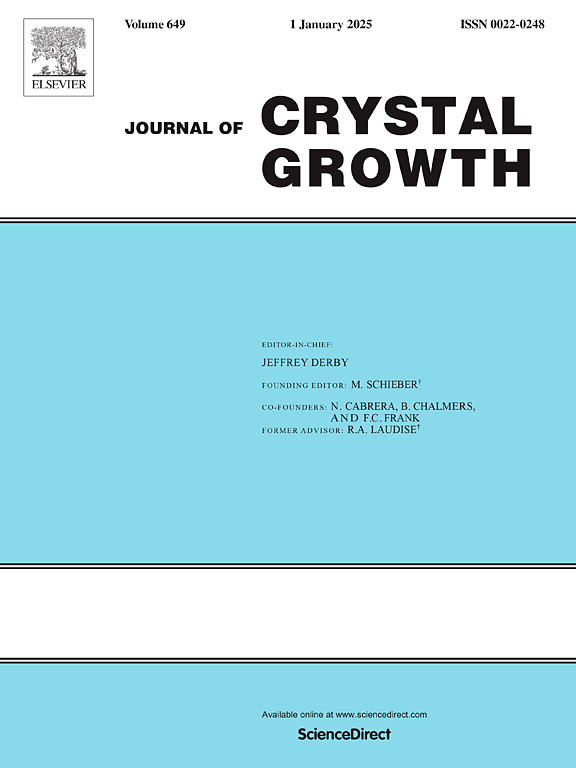Growth and characterization of n-type Ga2O3 films on sapphire substrates by APMOVPE
IF 1.7
4区 材料科学
Q3 CRYSTALLOGRAPHY
引用次数: 0
Abstract
In this study, n-type Ga2O3 thin films were grown on c-plane sapphire substrates by atmospheric pressure metalorganic vapor phase epitaxy using tetraethoxysilane (TEOS) as the silicon (Si) precursor. X-ray diffraction measurements confirmed that the deposited films were polycrystalline, predominantly consisting of the stable β-phase and the metastable κ-phase. Surface and optical characterizations indicated that lower growth temperature and appropriate Si doping reduce the grain size of three-dimensional Ga2O3 islands, thereby enhancing optical transmittance by mitigating surface scattering. Hall effect measurements demonstrated a maximum electron carrier concentration of approximately 1 × 1017 /cm3 at room temperature, while secondary ion mass spectrometry (SIMS) revealed that Si atomic concentrations were exceeding 1 × 1020 /cm3 in all n-type samples indicating low doping efficiency of Si. Carbon (C) impurities were also measured by SIMS with concentrations as the same order or higher than that of Si, implying they may be one of the reasons for the degraded electrical conductivity and originated from incomplete decomposition of the precursors during low temperature growth. From these results, it is crucial to reduce C impurities and enhance surface flatness to improve electrical and optical properties.
利用 APMOVPE 在蓝宝石衬底上生长 n 型 Ga2O3 薄膜并确定其特性
本研究使用四乙氧基硅烷(TEOS)作为硅(Si)前驱体,通过常压金属有机气相外延法在 c 平面蓝宝石衬底上生长了 n 型 Ga2O3 薄膜。X 射线衍射测量证实,沉积的薄膜是多晶体,主要由稳定的 β 相和易变的 κ 相组成。表面和光学特性分析表明,较低的生长温度和适当的硅掺杂可减小三维 Ga2O3 岛的晶粒尺寸,从而通过减少表面散射提高透光率。霍尔效应测量表明,室温下的最大电子载流子浓度约为 1 × 1017 /cm3,而二次离子质谱(SIMS)显示,所有 n 型样品中的硅原子浓度均超过 1 × 1020 /cm3,表明硅的掺杂效率较低。SIMS 还测出碳(C)杂质的浓度与硅的浓度相同或更高,这意味着碳(C)杂质可能是导电性降低的原因之一,源于低温生长过程中前驱体的不完全分解。从这些结果来看,减少 C 杂质和提高表面平整度对于改善电气和光学性能至关重要。
本文章由计算机程序翻译,如有差异,请以英文原文为准。
求助全文
约1分钟内获得全文
求助全文
来源期刊

Journal of Crystal Growth
化学-晶体学
CiteScore
3.60
自引率
11.10%
发文量
373
审稿时长
65 days
期刊介绍:
The journal offers a common reference and publication source for workers engaged in research on the experimental and theoretical aspects of crystal growth and its applications, e.g. in devices. Experimental and theoretical contributions are published in the following fields: theory of nucleation and growth, molecular kinetics and transport phenomena, crystallization in viscous media such as polymers and glasses; crystal growth of metals, minerals, semiconductors, superconductors, magnetics, inorganic, organic and biological substances in bulk or as thin films; molecular beam epitaxy, chemical vapor deposition, growth of III-V and II-VI and other semiconductors; characterization of single crystals by physical and chemical methods; apparatus, instrumentation and techniques for crystal growth, and purification methods; multilayer heterostructures and their characterisation with an emphasis on crystal growth and epitaxial aspects of electronic materials. A special feature of the journal is the periodic inclusion of proceedings of symposia and conferences on relevant aspects of crystal growth.
 求助内容:
求助内容: 应助结果提醒方式:
应助结果提醒方式:


